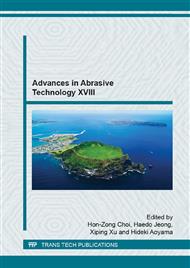[1]
Ioan D. Marinescu, Hans K. Tonshoff, Ichiro Inasaki. Handbook of ceramic grinding and polishing. NOYES Publications (2010).
Google Scholar
[2]
W. Brian Rowe. Principles of modern grinding technology. William Andrew. (2009).
Google Scholar
[3]
S . Malkin, T. W. Hwang. CIRP Annals - Manufacturing Technology, v 45, n 2, 1996, pp.569-580.
Google Scholar
[4]
K. Kitajima, G. Q. Cai, N. Kumagai, Y. Tanaka, H. W. Zheng. Study on Mechanism of Ceramics Grinding. Annals of the CIRP vol 41/1/(1992).
DOI: 10.1016/s0007-8506(07)61224-4
Google Scholar
[5]
G. Warnecke, U. Rosenberger, J. Miberg. Basics of Process Parameter Selection in Grinding of Advanced Ceramics. Annals of the CIRP Vol 44/1/(1995).
DOI: 10.1016/s0007-8506(07)62326-9
Google Scholar
[6]
Bi Zhang, Trevor D Howes. Material-Removal Mechanisms in Grinding Ceramics. Annals of the CIRP Vol 43/1/(1994).
DOI: 10.1016/s0007-8506(07)62219-7
Google Scholar
[7]
G. Warnecke, C. Barth. Optimization of the dynamic behavior of grinding wheels for grinding of hard and brittle materials using the finite element method. Annals of the CIRP Vol 48/1/(1999).
DOI: 10.1016/s0007-8506(07)63179-5
Google Scholar
[8]
E. Uhlmann. Surface formation in creep feed grinding of advanced ceramics with and without ultrasonic assistance. Annals of the CIRP Vol 47/1/(1998).
DOI: 10.1016/s0007-8506(07)62828-5
Google Scholar
[9]
Bi Zhang. An investigation of the effect of machine loop stiffness on grinding of ceramics. Annals of the CIRP Vol 50/1/(2001).
DOI: 10.1016/s0007-8506(07)62106-4
Google Scholar
[10]
T. Matsuo, M. Touge, H. Yamada. High-precision surface grinding of ceramics with superfine grain diamond cup wheels. Annals of the CIRP Vol 46/1/(1997).
DOI: 10.1016/s0007-8506(07)60818-x
Google Scholar
[11]
A. B. Yu, Y. S. Xu, S. F. Chen, B. Lin, B. Lin, X. L. Tian. Analysis of material removal in alumina ceramic honing. Journal of materials processing technology 129(2002) 167-170.
DOI: 10.1016/s0924-0136(02)00603-9
Google Scholar
[12]
J. Y. Shen, C. B. Luo, W. M. Zeng, X. P. Xu, Y. S. Gao. Ceramics grinding under the condition of constant pressure. Journal of materials processing technology 129(2002) 176-181.
DOI: 10.1016/s0924-0136(02)00636-2
Google Scholar
[13]
H. Huang, Y. C. Liu. Experimental investigations of machining characteristics and removal mechanisms of advanced ceramics in high speed deep grinding. International Journal of Machine Tools & Manufacture 43 (2003)811-823.
DOI: 10.1016/s0890-6955(03)00050-6
Google Scholar
[14]
Chien-Cheng Liu. Microstructural and reliability in grinding of silicon nitride. Materials Science and Engineering A 379 (2004) 437-442.
DOI: 10.1016/j.msea.2004.03.033
Google Scholar
[15]
Mohammad Rabiey, Nicolas Jochum, Fredy Kuster. High performance grinding of zirconium oxide (ZrO2) using hybrid bond diamond tools. CIRP Annals-Manufacturing Technology 62 (2013) 343-346.
DOI: 10.1016/j.cirp.2013.03.073
Google Scholar


